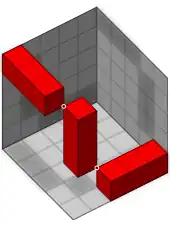
Pieces used in the Conway puzzle
Conway's puzzle, or blocks-in-a-box, is a packing problem using rectangular blocks, named after its inventor, mathematician John Conway. It calls for packing thirteen 1 × 2 × 4 blocks, one 2 × 2 × 2 block, one 1 × 2 × 2 block, and three 1 × 1 × 3 blocks into a 5 × 5 × 5 box.[1]
Solution

A possible placement for the three 1×1×3 blocks – the vertical block has corners touching corners of the two horizontal blocks
The solution of the Conway puzzle is straightforward once one realizes, based on parity considerations, that the three 1 × 1 × 3 blocks need to be placed so that precisely one of them appears in each 5 × 5 × 1 slice of the cube.[2] This is analogous to similar insight that facilitates the solution of the simpler Slothouber–Graatsma puzzle.

A step-by-step solution to the Conway puzzle
See also
References
- ↑ Weisstein, Eric W. "Conway Puzzle". MathWorld.
- ↑ Elwyn R. Berlekamp, John H. Conway and Richard K. Guy: winning ways for your mathematical plays, 2nd ed, vol. 4, 2004.
External links
This article is issued from Wikipedia. The text is licensed under Creative Commons - Attribution - Sharealike. Additional terms may apply for the media files.